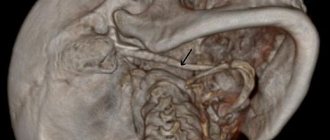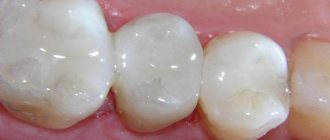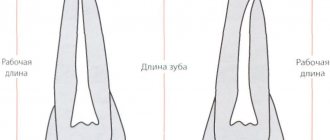Restoration. Repairing a chipped front tooth
Direct restoration
Indirect restoration
Restoration of the incisal edge
Selection of material for restoration
A chipped or broken front tooth is not a pleasant occurrence, from which no one is immune. Such an “accident” can happen at any time, even while eating. And how can you smile if instead of a whole tooth there is only half left? Fortunately, you can restore the beautiful shape of your teeth very quickly. This method is called restoration. What it is, what it is like, the main indications - this is discussed in our article.
Dental restoration is a special type of dental services aimed at improving the aesthetics of a smile. This procedure solves several problems at once: it improves the appearance of teeth, gives anatomical shape and restores the function of a damaged tooth.
There are direct and indirect restorations.
What types of caries are there?
There are several stages of the disease. They have a certain appearance and symptoms.
How to determine the stage of caries:
- In the spot stage: a white spot is observed on the surface of the enamel (focus of demineralization). The spot gradually turns brown. Enamel is the densest tissue in the human body, but due to various cariogenic factors it is gradually destroyed. Detecting the white spot is quite difficult.
- Medium caries: characterized by damage to the enamel-dentin junction in the form of a cavity, short-term sensitivity.
- Deep: extensive lesion affecting the deep layers of dentin. Pain appears from different types of irritants: mechanical, temperature, chemical.
Diagnosis of the disease is carried out using a visual examination and an x-ray. The image will show violations of the integrity of the enamel and dentin with uneven contours.
Direct restoration
During direct restoration, the doctor places a filling material on the tooth. It is comfortable and flexible, able to take the shape specified by the dentist. The color does not differ from the shade of native enamel, and at the same time it is highly durable.
This method is suitable for minor corrections:
- restoration of chipped front teeth;
- crack in the enamel;
- tooth restoration after removal of fragments destroyed by caries;
- color correction;
- gap between teeth.
Stages of direct restoration
- The doctor places a rubber dam on top of the tooth. This is a device made of latex and a holding frame. It is necessary to prevent saliva and germs from getting onto the work area, otherwise this will worsen the properties of the filling material.
- Selection of enamel shade.
- Restoration of teeth with filling material using a matrix. This is a dental instrument that allows you to recreate the anatomy of a tooth. Using the matrix, the doctor verifies the contact gaps between the teeth and maintains the boundary of the layer-by-layer application of the composite.
- Carefully polish the tooth using a brush and paste.
Before the procedure, professional oral hygiene is required. It cleans teeth of plaque and microbes and makes it possible to accurately determine the color of the enamel.
Advantages
- Efficiency. Tooth restoration can be done in one appointment.
- Naturalness. The shade is selected in accordance with the shade of your natural teeth.
- Safety. The affected tooth does not require grinding; neighboring teeth also remain unharmed.
One of the disadvantages is that over time, teeth restored with composite material may become dull. Most often this happens due to non-compliance with hygiene rules and the wrong choice of toothpaste.
Artistic restoration of teeth
Prices for treatment of wedge-shaped dental defects
If you start treating a wedge-shaped defect in the early stages, treatment measures will be aimed at restoring the enamel structure using conservative methods without preparation.
A pronounced depression requires more serious manipulation and restoration of the crown of the tooth using various therapeutic and orthopedic methods. The difficulty of treating deep defects is due to the small thickness of the cervical region, because there is always a risk of accidental opening of the pulp chamber. Of course, this factor affects the cost of treatment - simple remineralization therapy is cheaper than stage-by-stage tooth restoration, which requires jeweler precision from the doctor in especially severe cases.
The specifics of the disease require the use of more complex medical techniques using special instruments and high-tech materials (it will not be possible to simply fill a tooth; the filling will fall out after some time). You also need to take into account the prices for microprosthetics - installing veneers or lumineers is more expensive than restoration work.
The “Smile Factor” has introduced effective methods for treating wedge-shaped defects, and prices remain at an affordable level even for high-tech services. Regular discounts and promotions will help solve the problem without much damage to your finances - the doctor will offer the most reliable and profitable options without extra costs.
Modern methods of treatment
Damage to teeth due to a wedge-shaped defect is eliminated in several ways. The treatment plan is drawn up individually after determining the stage of the disease and the number of teeth affected.
Fluoridation of enamel
The procedure involves a course of applications with preparations based on calcium and fluoride. For the best penetration of ions into tooth tissue, electrophoresis is often prescribed. Fluoridation makes it possible to compensate for the lack of fluorides in enamel, increase its resistance to external influences, and reduce sensitivity to acids.
Remineralization
Small defects a few millimeters in size do not require filling - remineralization of enamel and dentin with special preparations (for example, enamel-sealing liquid) shows a good effect. The number of sessions is determined by the doctor; after each procedure, the enamel is covered with fluoride varnish to create a protective film.
Orthodontic treatment
In case of malocclusion, it is necessary to normalize the relationship of the dentition, which is achieved by installing a brace system or other orthodontic devices. The process can take up to 2 years, but this eliminates the root cause of the disease, chewing pressure is distributed evenly without overloading individual teeth. In some cases, the help of an orthopedist is indicated, who carries out selective grinding of some units to eliminate premature contact between the upper and lower teeth.
Installing a filling or crown
For moderate defects, filling is indicated, and before treatment it is necessary to relieve the affected tooth as much as possible in order to avoid the filling falling out. For filling, the doctor uses fluid-flowing composites, the high elasticity of which “smoothes out” the increased load and ensures a good marginal fit of the filling. Deep defects that pose a risk of tooth fracture are eliminated by installing ceramic or metal-ceramic crowns.
Veneers or Lumineers
To improve aesthetics and prevent relapses, filled teeth can be covered with veneers or lumineers. These are the thinnest ceramic veneers that are installed on the outside of the teeth. Veneers are chosen when the enamel has a “reserve” of thickness for minimal preparation. If the enamel is very thin, it is preferable to install lumineers, which do not require prior removal of a layer of tissue.
Recommendations from experts
After restoration work, a “clear” diet should be followed for several days to prevent staining of the material. When installing veneers or lumineers, you must avoid increased chewing load and do not break hard foods and objects with your teeth.
Particular attention should be paid to preventing night teeth grinding, and do not neglect wearing mouth guards prescribed by a specialist. The doctor will also select for you a suitable toothpaste with a remineralizing effect, as well as products that reduce hypersensitivity (gels, rinses with fluoride).
Tip: when using remineralizing pastes and gels, it is recommended to hold the foam in your mouth for 40-60 seconds, which will allow fluoride and calcium ions to penetrate deeper into the enamel pores.
Prognosis and prevention
The prognosis of the disease is favorable, especially if the patient sought dental care in the early stages. Complex treatment eliminates the resulting defect, restoring the aesthetics and functionality of the affected teeth.
Preventive measures to prevent a wedge-shaped defect:
- Using toothbrushes with soft bristles of uniform length;
- “Sweeping” movements when brushing teeth without pressing on the enamel;
- Limiting the consumption of carbonated drinks, sour juices;
- Protecting teeth from increased stress (gnawing seeds, nuts);
- Treatment of conditions accompanied by increased stomach acidity;
- Maintaining an optimal balance of microelements in the body.
Simple measures will help maintain the achieved treatment results and prevent the formation of new defects.
Still have questions? Make an appointment!
An accurate diagnosis with the development of a correct treatment plan is only possible in an equipped clinic, where the doctor uses all his experience to solve the patient’s problem.
“Smile Factor” invites you to come for a consultation to undergo a highly accurate diagnosis, find out all the treatment options in your case, get a predictable result - and all this at reasonable prices! We keep the cost of our services at a truly affordable level so that our patients are satisfied with all aspects of the clinic. You can make an appointment at a time convenient for you - you can make an appointment with a doctor by phone or using the online form. Waiting for you!
Restoration of the incisal edge
Enamel is the hardest tissue in our body. But over time, it becomes thinner, including due to improper brushing techniques or the use of abrasive pastes. This is fraught with the appearance of microcracks and chips on it. Especially at risk are those who have bad habits: chewing seeds, nuts, or the tip of a ballpoint pen. Restoration of the cutting edge of the tooth helps to correct the shape of the tooth and its cutting edge, and hide enamel defects.
This is not an easy procedure that requires painstakingness and creativity, because the anatomical shape of everyone’s teeth is different. In addition, the tooth has a relief, individual shade and transparency. The specialist’s task is to make sure that the restored tooth does not differ from the rest.
Front Tooth Reconstruction. Source: Futurism YouTube channel
Few people know that the color of the enamel changes from the neck to the cutting edge. It seems that the changes are insignificant, but if this feature is not taken into account, the restored tooth will look like a plastic crown. The same can be said about transparency.
Stages of development of the defect
In modern dental practice, it is customary to distinguish the following stages of development of wedge-shaped dental defects:
- initial (tissue loss is not noticeable to the naked eye, the patient may complain of a slight increase in tooth sensitivity);
- superficial (presence of visible defects 0.3 mm deep and less than 3.5 mm long);
- medium (the appearance of defects up to 4 mm long and 0.4 mm deep, formed by two planes located relative to each other at a slight angle);
- deep (the appearance of a defect reaching a length of 5 mm, non-carious damage to dentin).
According to statistics, initial and superficial wedge-shaped defects are most often found in young people, and deep and medium ones - in older people.
Selection of material for restoration
For direct tooth restoration, special composite materials are used, which have high strength, ductility, and also help achieve the effect of tooth transparency.
Most popular materials:
- Filtek (USA) - considered a universal material. It is suitable for restoring anterior teeth and chewing teeth. The main thing is to choose the right shade.
- Venus (Germany) is a more expensive option for the restoration of anterior teeth. The material consists of nanoparticles, which helps to achieve maximum aesthetic effect.
- Enamel Plus (Italy) - sometimes it is called a “chameleon” for its ability to adapt to its native enamel color.
- During indirect restoration, ceramics, zirconium dioxide, and metal ceramics are used.
What to do if caries appears on teeth
First of all, you need to immediately contact your dentist. When a tooth is destroyed due to caries, treatment cannot be delayed. Otherwise, the complications described above arise. It is worth noting that no available means at home will relieve the patient of this problem. Only a dentist can cure this disease.
You should also pay attention to your oral hygiene:
- Brush your teeth at least twice a day.
- Use floss and mouth rinses.
- Visit your dentist for a checkup every six months.
- Come for professional hygiene every 6 months.
Dentists will help you select individual hygiene products (brushes, pastes, threads, rinses) at your appointment. The doctor will also determine why dental caries appears in your particular case and give the necessary recommendations.










